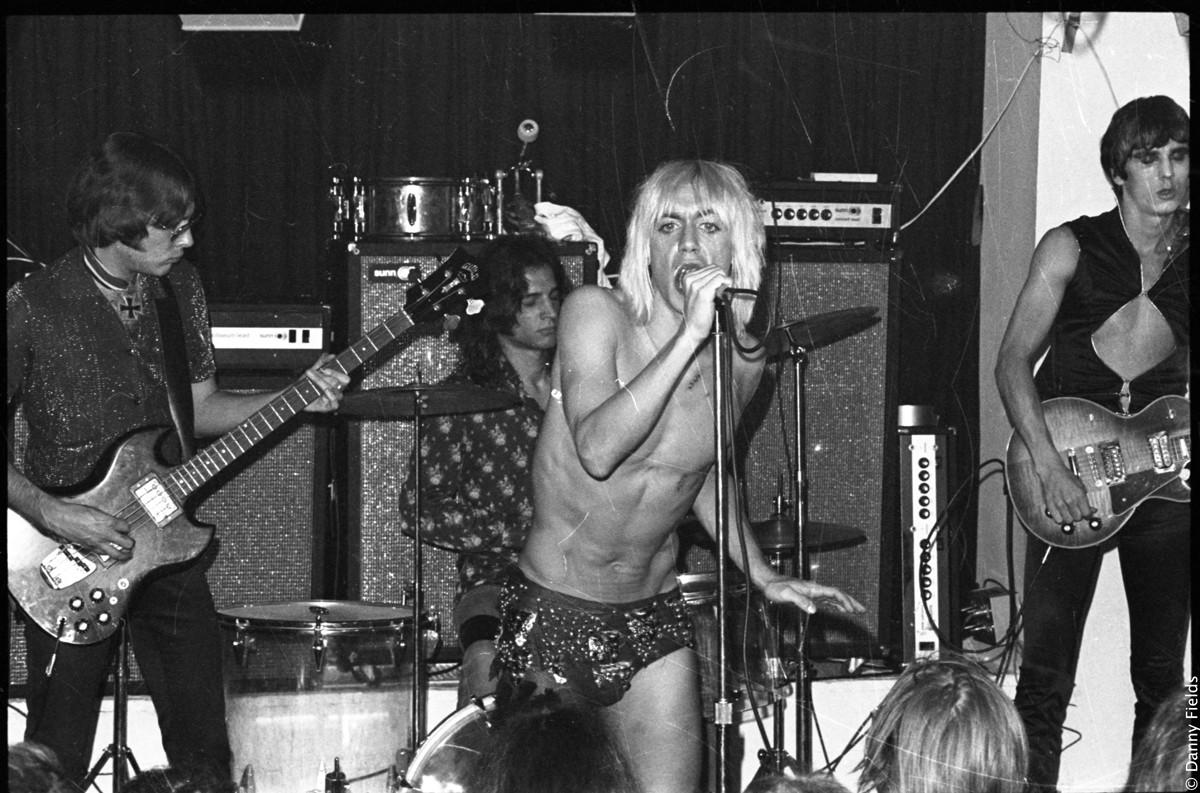
Wherever you believe the sound of punk originated from, you cannot disagree that the primal energy generally associated with punk performance was invented by Iggy Pop in the late 1960s. Pop's crazed vocals, public nudity, self-inflicted wounds, aggression toward the audience (he'd often flip off and berate the crowd) and creation of the stage dive divided the barrier between performer and audience in an era when even “rebellious” peace and love music was commodified and controlled for the masses. As innovators of a new sound and musical approach, at odds with the counterculture model of hippies and Woodstock, where did Iggy and the Stooges fit in?
In Jim Jarmusch's documentary Gimme Danger, the answer to that question is nowhere—at least not back then. The film opens at the band's breaking point in 1971, when commercial failure, audience violence, excessive drug use and being dropped from their label, Elektra Records, led to the Stooges' first dissolution. But as the film proves, the group were ahead of their time, combining a myriad of musical influences including R&B, blues, jazz, experimental, and psychedelic rock, years later inspiring future bands such as the Sex Pistols, the Damned, the Dead Boys, Bad Brains, the White Stripes and the Clash to take the stage with their own raw power. In Jarmusch's summation, the Stooges are the “greatest rock & roll band ever.”
Gimme Danger takes on a straightforward narrative approach in documenting the history of the group, from their salad days in Ann Arbor, Michigan, to their inclusion in the University of Michigan's radicalism to their various break ups to their re-evaluation as rock & roll legends, being inducted into the Rock and Roll Hall of Fame, and reuniting in the early 2000s. Themes of exploitation and distrust of the music industry pervade the film, as the man born Jim Osterberg details his interactions with record-company execs who sought to exploit his popularity. Funny and relevant archival footage from classic films and television shows fill the gaps of lost footage or photographs. Sometimes it works, especially when chopped up in quick cuts to match the snarling fuzz guitar that opens “I Wanna Be Your Dog.” Over time, though, it becomes a bit grating.
Despite access to the legendary members onscreen (some for the last time—both Asheton brothers, Scott and Ron, as well as saxophone player Steve Mackay have passed away since filming their interviews), the film supplies matter-of-factly reported details of events with little thought or analysis about them, creating more questions than answers. Did the Ashetons ever feel forgotten in that gap of time between the Stooges' last break up in 1974 and their Coachella reunion in 2003, when Pop launched a successful solo career? What about Pop's recorded stints in an asylum and rehab clinics after the band's first break up in 1971? There are plenty of stories about drug use and meetings with famous people (the John Wayne story was particularly hilarious), but those looking for the most lurid anecdotes would be better off reading Legs McNeil and Gillian McCain's seminal oral history on punk, Please Kill Me.
Where Gimme Danger succeeds most is providing diehard Stooges fans with insider knowledge on the development of their sound, followed by rare audio from recording sessions and concert footage of Pop prowling onstage in the prime of his youth, his wild blue eyes shining bright. Pop hasn't lost any of his charisma and humor and is a delight to watch and listen to. Plus, listening to the other Stooges—the Ashetons, John Williamson, Mackay, and temporary bassist Mike Watt—is a rare pleasure.
Film-lovers and fanatics of Jarmusch's oeuvre might not be as crazy about Gimme Danger, but rock enthusiasts will appreciate being spoiled with seeing Iggy Pop be interviewed about his life and the Stooges. In a year that saw the loss of three of the biggest rock icons of the 20th century—Lemmy, Bowie and Prince—an homage to Pop's influence and legacy while still alive feels especially crucial. But ask Iggy yourself where he fits in now, and he'll give you a long list at the film's conclusion of who he doesn't fit in with: glamorous people, radicals, hip-hop-heads, alternative crowds, artsy types, etc. “I don't want to fit in with anyone but myself,” Pop says.
There's nothing more punk rock than that.
Gimme Danger was directed by Jim Jarmusch. Opens in Orange County theaters on Nov. 4.
Aimee Murillo is calendar editor and frequently covers film and previously contributed to the OCW’s long-running fashion column, Trendzilla. Don’t ask her what her favorite movie is unless you want to hear her lengthy defense of Showgirls.

